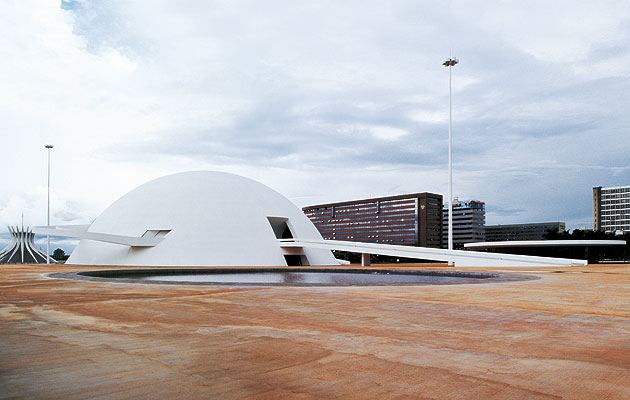|
Oscar Niemeyer’s National Museum of the Republic, Brasilia, with his cathedral, left (image: Cristobal Palma) |
||
|
A city can work as a city and as a symbol. Occasionally it can work as a symbol but not as a city. Brasilia is one such city. The city of the future turns 50 this year (2010). It was conceived in a spasm of hubris and an aching desire to break with the colonial past and thrust Brazil into the modern world, a multiracial, democratic, emerging country of independent vision and determination. Its awesome, beautiful-bleak centre is defined by a sci-fi vision of vast planes of public space punctuated by buildings of a slightly fey yet sublime elegance. It exudes the power of its convictions and all the failures of modernist planning. I don’t know whether the architect of its best buildings, Oscar Niemeyer, the city’s planner, Lucio Costa, and president Juscelino Kubitschek looked out of their plane and saw its shadow on the jungle below, which inspired the strange winged central plan, but it’s a nice myth. This is a city with no reference to the topology, to the landscape. Niemeyer is a dedicated communist (his cigars are still sent to him by his good friend Fidel Castro) yet there is no mistaking the similarity to the colonial model, the beautiful president’s palace with its colonnaded verandas, the landowners at the centre, the rest in the slums around the edges. “Brasilia could never be the city of the future,” Niemeyer confessed to me six years ago (in a quote I later realised he uses on all journalists) “because our society remains that of the past.” Sitting in his modest office in an Art Deco apartment overlooking Copacabana Beach, Niemeyer was acutely aware of the deficiencies of Brasilia. When I asked him would he want to live there, he grinned sheepishly and said he couldn’t do without the beaches, the gorgeous women and the vibrant life of Rio. Yet there is no denyingthat the city displays some of the 20th century’s greatest monuments, like an architecture expo of a modernism that somehow could have been. Niemeyer’s centerpiece, the National Congress with its dish and dome and its own twin towers is a direct translation of his sketch, one of the few indelible images of a government building, even though it looks a little like a Madison Avenue executive ashtray circa 1960. The Alvorada and Itamaraty palaces play with the arches of the Beaux Arts, stretching, inverting, attenuating them into delicate, elegant forms. Then there’s that extraordinary cathedral, again by Niemeyer, a crown of thorns or, it has been suggested, a pineapple. Totally tropical taste. But it’s all breathtakingly dead. It feels like an abandoned vision of the future, or like the epic memorials Mussolini erected to celebrate the war dead in out-of-the-way places, part national image building, part labour creation, part megalomania, the architecture of memory. Huge, bleak spaces roasted by the sun. The effect is reinforced by the tombstone slabs of the dumb, perfect office blocks which line the central plaza, eloquent ciphers for faceless bureaucracy halfway between Corb’s blankly sketched slabs and the hygienic dystopia of Jacques Tati’s Playtime. Brasilia is that terrible thing, a beautiful failure. Its architecture is exquisite, its ambitions are noble, but who, really, wouldn’t rather be in Rio? |
Words Edwin Heathcote |
|
|
||



















